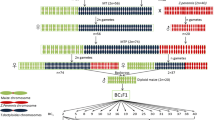Summary
Cytogenetic evidence has shown that teosinte (Zea mays ssp. mexicana (Schrad.) Iltes) and maize (Zea mays L. ssp. mays) are conspecific. They hybridize readily and their offspring are generally fertile. Teosinte could not have originated as a byproduct of maize-Tripsacum hybridization. Such introgression gave rise to plants that are phenotypically maize or Tripsacum, depending on which parent was used as a pollen donor. Compartive morphological and genetical studies indicated that it is more probable that maize originated from a teosinte-like ancestor under domestication, than that a maize-like plant gave rise to teosinte through a series of mutations.
Similar content being viewed by others
References
Anderson, E., 1944. Homologies of the ear and tassel in Zea mays. Ann. Missouri Bot. Gard. 31: 325–342.
Beadle, G. W., 1932. The relation of crossing-over to chromosome association in Zea-Euchlaena hybrids. Genetics 17: 481–501.
Beadle, G. W., 1972. The mystery of maize. Field Mus. Nat. Hist. Bull. 43, No. 10.
Borgaonkar, D. S. & J. M. J. de Wet, 1964. Cytogenetical study of hybrids between Dichanthium annulatum and D. fecundum. III. Phyton 21: 50–60.
Clayton, W. D., 1973. The awnless species of Andropogoneae. Kew Bull. 28: 49–58.
Collins, G. N., 1919. Structure of the maize ear as indicated in Zea-Euchlaena hybrids. J. agric. Res. 17: 127–136.
Collins, G. N., 1921. Teosinte in Mexico. J. Heredity 12: 339–350.
Collins, G. N. & J. H. Kempton, 1920. A teosinte-maize hybrid. J. agric. Res. 19: 1–38.
Collins, G. N. & A. E. Longley, 1935. A tetraploid hybrid of maize and perennial teosinte. J. agric. Res. 50: 123–133.
Cutler, H. C. & A. E. Anderson, 1941. A preliminary survey of the genus Tripsacum. Ann. Missouri Bot. Gard. 28: 249–269.
De Wet, J. M. J., 1975. Evolutionary dynamics of cereal domestication. Bull. Torrey Bot. Club 102: 307–312.
De Wet, J. M. J. & J. R. Harlan, 1972. Origin of maize: The tripartite hypothesis. Euphytica 21: 67–70.
De Wet, J. M. J. & J. R. Harlan, 1974. Tripsacum-maize interaction: A novel cytogenetic system. Genetics 78: 493–502.
De Wet, J. M. J. & J. R. Harlan, 1975. Weeds and domesticates: Evolution in the man-made habitat. Econl Bot.: In press.
De Wet, J. M. J. & J. R. Harlan, 1976. Tripsacum and the origin of maize. In: D. B. Walden (Ed.), Genetics and breeding of maize. John Wiley and Sons, New York. In press.
De Wet, J. M., J. R. Harlan & C. A. Grant, 1971. Origin and evolution of teosinte (Zea mexicana (Schrad.) Kuntze). Euphytica 20: 255–265.
Engle, L. M., J. M. J. De Wet & J. R. Harlan, 1974. Chromosome variation among offspring of hybrid derivatives with 20 Zea and 36 Tripsacum chromosomes. Caryologia 27: 193–209.
Galinat, W. C., 1970. The cupule and its role in the origin and evolution of maize. Univ. Mass. agric. Exp. Stn Bull. 585.
Galinat, W. C., 1971. The origin of maize. Ann. Rev. Genet. 5: 477–478.
Harlan, J. R., J. M. J. De Wet & E. G. Price, 1973. Comparative evolution of cereals. Evolution 27: 311–325.
Hitchcock, A. S., 1922. A perennial species of teosinte. J. Wash. (DC) Acad. Sci. 12: 205–208.
Longley, A. E., 1934. Chromosomes in hybrids between Euchlaena perennis and Zea mays. J. agric. Res. 48: 789–806.
Mangelsdorf, P. C., 1958. Ancestor of corn. Science 128: 1313–1320.
Mangelsdorf, P. C., 1961. Introgression in maize. Euphytica 10: 157–168.
Mangelsdorf, P. C., 1968. Cryptic genes for ‘tripsacoid’ characteristics in Maiz Amargo of Argentina and other Latin American varieties. Bol. Soc. Argent. Bot. 12: 180–187.
Mangelsdorf, P. C., 1974. Corn its origin, evolution and improvement. Belknap Press of Harvard Univ., Cambridge, MA.
Mangelsdorf, P. C., R. S. MacNeish & W. C. Galinat, 1964. Domestication of corn. Science 143: 538–545.
Mangelsdorf, P. C., R. S. MacNeish & W. C. Galinat, 1967. Prehistoric wild and cultivated maize. In: Byers, D. S. (Ed.). The prehistory of Tehuacan Valley. Univ. Texas Press, Austin, TX.
Mangelsdorf, P. C. & R. G., 1939. The origin of Indian corn and its relatives. Texas agric. Exp. Stn Bull. 574.
Newell, C. A. & J. M. J. De Wet, 1974. Morphology of some maize-Tripsacum hybrids Amer. J. Bot. 61: 45–53.
Randolph, L. F., 1955. History and origin of corn. II. Cytogenetic aspects of the origin and evolutionary history of corn. In: Sprague, G. F. (Ed.), Corn and corn. improvement. Academic Press, NY.
Rogers, J. S., 1950. The inheritance of inflorescence characters in maize-teosinte hybrids. Genetics 35: 541–558.
Shaver, D. L., 1962. Cytogenetic studies of allotetraploid hybrids of maize and perennial teosinte. Amer. J. Bot. 49: 348–354.
Wilke, P. J., R. Bettinger, T. F. King & J. F. O'Connell, 1972. Harvest selection and domestication in seed plants. Antiquite 46: 202–208.
Wilkes, H. G., 1967. Teosinte: The closest relative of maize. Ph.D. thesis Bussey Inst., Harvard Univ. Publ., Cambridge, MA.
Author information
Authors and Affiliations
Additional information
Reseach supported financially by the Illinois Agricultural Experiment Station, and Grants GB-40136-X and BM573-01034 A02 from the National Science Foundation.
Rights and permissions
About this article
Cite this article
de Wet, J.M.J., Harlan, J.R. Cytogenetic evidence for the origin of teosinte (Zea mays ssp. Mexicana). Euphytica 25, 447–455 (1976). https://doi.org/10.1007/BF00041578
Received:
Issue Date:
DOI: https://doi.org/10.1007/BF00041578




